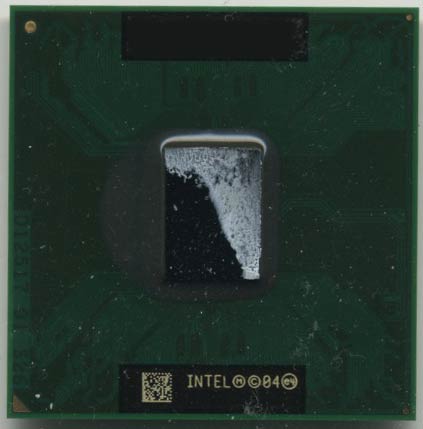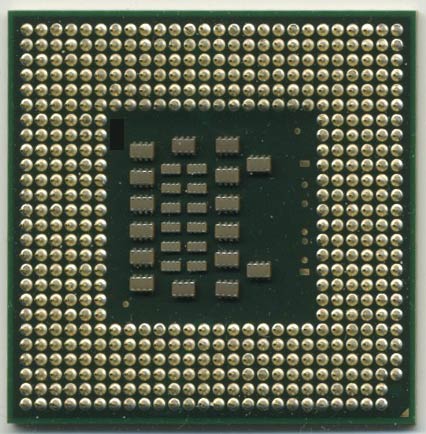Intel Yonah Performance Preview - Part I: The Exclusive First Look at Yonah
by Anand Lal Shimpi on November 30, 2005 2:50 AM EST- Posted in
- CPUs
Intel, oh Intel, how uninteresting your processors have been to us for so long now. Where have the days of the Northwood gone? Prescott brought us a minor bump in clock speed, minor increases in performance, and more importantly - major increases in power bills. But if any company can go down the wrong path for five years and still come out on top, it’s Intel. So starting next year, we’ll start seeing a new Intel. A more power conscious Intel and to kick it all off will be Intel’s first Earth-friendly dual core processor: Yonah.
As the successor to the current Pentium M (Dothan) and the predecessor to next year’s Conroe, Merom and Woodcrest cores, Yonah is a very important chip. As a mobile processor Yonah will bring dual core to thin and light notebooks, basically anywhere you’d find a Pentium M, you’ll now be able to find two Pentium Ms. The implications for mobile performance are huge, as multitasking on notebooks has rarely been all that great of an experience. At the same time, Yonah is so much more than just a dual core mobile processor - it’s a predictor of the performance of Intel’s next-generation desktop micro-architecture. Sure, it won’t have all of the architectural bells and whistles that we’ll see when Conroe debuts at the end of next year, but it’ll have many and that makes it a reference point.
The problem with the Pentium M architecture has been that although it’s traditionally done well at office tasks and obviously in the power consumption department, it has lagged behind the Pentium 4 and Athlon 64 when it comes to FP intensive applications such as video encoding, and to a lesser degree, 3D gaming. With Yonah, Intel has promised to address those performance issues, and even more so with their next-generation micro-architecture later next year. But we tend to want to see things for ourselves, and Yonah will at least give us an indication of how things have improved since Dothan, and whether or not Intel is on the right track to replacing the Pentium 4.
By now we’ve hopefully stressed the importance of Yonah, and there’s just one more detail to mention - we have one.
The Platform - Yet Another Socket
While the launch of Yonah still won’t be until January of next year, we’ve had a chip for the past month, unfortunately, we haven’t had a motherboard to stick it in. We finally got one two days ago, which is why you’re seeing this article now, instead of more pictures of our Yonah posing alongside the Xbox 360. The problem is that Intel seems to have changed sockets once more, meaning that Yonah is not backwards compatible with the original Pentium M socket.

If you’ll remember back to the introduction of the Pentium M, Intel introduced a brand new socket for the processor: Socket-479. Back then, the desktop Pentium 4 still used the pin-based Socket-478, so the different pin-out was a bit of a pain to deal with as we all wanted to be able to stick Pentium Ms in our Pentium 4 motherboards.

The Yonah socket is still a 479-pin interface, however the pin-out has been changed once more, and of course Yonah won’t even physically fit into any current Pentium M motherboards. Instead, you’ll need a brand new motherboard with a brand new chipset. So if you invested in any of the handful of desktop Pentium M motherboards that were released over the past year, you’re unfortunately out of luck.

Yonah (left) vs. Dothan (right) - Note the different pin-out
What’s this about a new chipset? Well, it’s not exactly a new chipset, rather it’s Intel’s mobile 945 chipset - the mobile version of the desktop chipset we’ve had for quite some time now. The platform we’re testing on in particular uses Intel’s 945G chipset, with integrated graphics, but of course we aren’t too interested in integrated graphics performance so we’ll be using the PCIe x16 slot on the board.
While we can’t tell you who makes the motherboard we’re testing with, the important thing to note is that it is a desktop motherboard made specifically for Yonah. It’s got a single PCIe x16 slot, meaning you don’t have to rely on integrated graphics, and all of the bells and whistles you’d expect from a desktop motherboard; this could very well be the heart of your next system.
We’ve been hearing that Pentium M based desktops will become a lot more common next year, and this motherboard is definitely an indication of that.










135 Comments
View All Comments
NeonAura - Wednesday, November 30, 2005 - link
Yonah seems pretty good. Looks to be doing a good job. But I wonder, how much is that 2.0 ghz Yonah chip going to cost? Retail at launch: $400-$450 is my guess. An AMD X2 3800+ is cheaper than that by a bit, and barely sacrifices any performance. The thing is, AMD is just sitting here watching Intel like Intel used to watch them. AMD is waiting for Intel's next move, meanwhile they're ready to start pimping out some fine chips. The Yonah is going to be released Jan-Feb 2006, while the X2's were released June 2005.AMD will be ready for Intel, Intel just doesn't know it yet. I'm not a fanboi, but Intel is going to have to throw up some hail marys to take down AMD with the Yonah, Conroe or whatever chips they may have coming. Because AMD hasn't been sitting on their behinds for the past six months. AMD is just being secretive, they want to surprise Intel by putting out their chip that they haven't really talked about right at the same time as Intel puts out Yonah.
AMD will be playing the same game as Intel soon enough, and Intel better put these chips as cheap as they possibly can or they'll be taken down.
mav99 - Wednesday, November 30, 2005 - link
1. intel has confirmed that merom will be compatible with the new upcoming yonah motherboards. you only need a bios update.2. the chipset should support ddr2-667 to match the 667 fsb. why did they use ddr2-533 for the article?
yzkbug - Wednesday, November 30, 2005 - link
My main concern is whether new Conroe/Merom will be compatible with Yonah socket. I hate upgrading the motherboard every time I upgrade my CPU. AMD is definitely better in this respect.Zebo - Friday, December 2, 2005 - link
Well times are changing- No more 5 years of socket A. AMD doing like Intel nowerdays switching sockets every year..year and half. M2 is coming next year. Before that we had 940 for FX's then 754 and now 939...fitten - Thursday, December 1, 2005 - link
I typically upgrade my motherboard when I upgrade the CPU as well.... even on my AMD systems. By the time I'm ready to upgrade the CPU, there are typically better boards (more features, better chipset, etc.) around to take better advantage.Example, if you bought a Via chipset board with your first Athlon64, it's probably worth spending the extra $85 for a new motherboard to get an nForce4 or better chipset with your new CPU. You can probably get an increase in performance just keeping your old CPU and upgrading the motherboard... especially in features.
Shintai - Wednesday, November 30, 2005 - link
Merom yes, Conroe..will both yes and no. Conroe will use 1066FSB, Meron/Yonah 667FSB. So a Conroe on a Yonah board might be slow due to FSB and multiplier.Leper Messiah - Wednesday, November 30, 2005 - link
Sooo...yeah. Intel's possible $500+ notebook part thats coming out next year is competive with AMD's currently out $325 desktop part in basically all things, ya know. Except that price thing, and that whole 64-bit thing. Be interesting to see the OC numbers on this and how high they want to take the speeds. As of right now though, meh.fitten - Thursday, December 1, 2005 - link
Those are pretty good things for a chip destined for your laptop to have... which is where that X2 won't be going (for obvious reasons).If you look at this article as being a comparison of desktop systems, then it is pretty ho-hum. If you look at it like you'll be able to have this in a (hopefully) 4-5 lbs laptop and still get over 3 hours (maybe even up to 5) off a battery while you are on the road, then it is a bit more interesting.
Leper Messiah - Thursday, December 1, 2005 - link
See, I (and quite frankly most people) don't even need dual core performance in a laptop. The only way I could actually see my self going out and actually spending money on either one, Yonah or dual core turion is if it was to be my only computer. I don't understand why lap top users need this much power. And I guarentee Intel will make it uber expensive.stateofbeasley - Thursday, December 1, 2005 - link
http://www.theinquirer.net/?article=27770">http://www.theinquirer.net/?article=27770The price points are the same as existing Pentium M processors. I don't know why people make the assumption that Yonah will somehow be super expensive, because that's just not true.